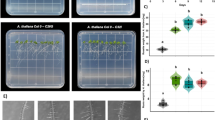Abstract
Decomposing onions at certain microbial successional stages produce potent volatile attractants and ovipositional stimulants of the onion fly,Delia antiqua (Diptera: Anthomyiidae). A reproducible source of these compounds was obtained by culturingErwinia carotovora var.carotovora (EC) on sterile onion tissue. In laboratory choice tests, EC-inoculated onion was more attractive thanKlebsiella pneumoniae (KP) cultured on onion, EC cultured on potato (a nonhost of onion fly), or the chemical synthetic baits dipropyl disulfide and an aqueous solution of 2-phenylethanol and pentanoic acid. Onion flies were mildly attracted to potato after inoculation with EC, but females did not accept EC-inoculated potato for oviposition. This work emphasizes that sources of semiochemicals may need to be defined microbiologically as well as physically and chemically.
Similar content being viewed by others
References
Aorios, G.N. 1978. Bacterial soft rots, pp. 477–483,in Plant Pathology. Academic Press, New York.
Block, E. 1985. The chemistry of garlic and onion.Sci. Am. 252:114–119.
Cox, C.D., andParker, J. 1979. Use of 2-aminoacetophenone production in identification ofPseudomonas aeruginosa.J. Clin. Microbiol. 9:479–484.
Cuppels, D., andKelman, A. 1974. Evaluation of selective media for isolation of soft-rot bacteria from soil and plant tissue.Phytopathology 64:468–475.
Dindonis, L.L., andMiller, J.R. 1981a Onion fly and little house fly host finding selectively mediated by decomposing onion and microbial volatiles.J. Chem. Ecol. 7:419–426.
Dindonis, L.L., andMiller, J.R. 1981b. Onion fly trap catch as affected by release rates of n-dipropyl disulfide from polyethylene enclosures.J. Chem. Ecol. 7:411–418.
Freeman, G.G. 1975. Distribution of flavour components in onion (Alliumcepa L.), leek (Allium porrum) and garlic (Allium sativum).J. Sci. Food Agric. 26:471–481.
Gill, J.L. 1978, Design and Analysis of Experiments in the Animal and Medical Sciences, Vol. 1. Iowa State University Press, Ames, Iowa.
Harris, M.O., andMiller, J.R. 1983. Color stimuli and oviposition behavior of the onion fly,Delia antigua (Meigen) (Diptera: Anthomyiidae).Ann. Entomol. Soc. 76:766–771.
Havukkala, I.J., andMiller, J.R. 1987. Daily periodicity in the ovipositional behavior of the onion fly,Delia antiqua (Diptera: Anthomyiidae).Environ. Entomol. 16:41–44.
Ishikawa, Y., Ikeshoji, T., andMatsumoto, Y. 1981. Field trapping of the onion and seed-corn flies with baits of fresh and aged onion pulp.Appl. Entomol. Zool. 16:490–493.
Ishikawa, Y., Matsumoto, Y., Tsutsumi, M., andMitsui, Y. 1984. Mixture of 2-phenylethanol and n-valeric acid, a new attractant for the onion and seedcorn flies.Hylemya antiqua andH. platura (Diptera: Anthomyiidae).Appl. Entomol Zool. 19:448–455.
Kelman, A., andDickey, R.S. 1980Erwinia. 2. Soft rot or carotovora group, pp. 31–35,in N.W. Schaad (ed.). Laboratory Guide for Identification of Plant Pathogenic Bacteria. American Phytopathology Society, St. Paul, Minnesota.
Larsson, L., Mardh, P.A., andOdham, G. 1984. Analysis of volatile metabolites in identification of microbes and diagnosis of infectious diseases, pp. 207–235,in G. Odham, L. Larsson, and P.-A. Mardh (eds.). Gas chromatography/Mass Spectrometry, Applications in Microbiology. Plenum Press, New York.
Lee, M.L., Smith, D.L., andFreeman, L.R. 1979. High resolution gas chromatographic profiles of volatile organic compounds produced by microorganisms at refrigerated temperatures.Appl. Environ. Microbiol. 37:86–90.
Lelliott, R.A. 1974. Description of the species of the genusEnvinia, pp. 469–476,in R.F Buchanan and N.E. Gibbons (eds.). Bergey's Manual of Determinative Bacteriology, 8th Ed. Williams & Wilkins, Baltimore, Maryland.
Matsumoto, Y., andThorsteinson, A.J. 1968. Effect of organic sulfur compounds on oviposition in onion maggot,Hylemya antiqua Meigen (Diptera: Anthomyiidae).Appl. Entomol. Zool. 3:5–12.
Miller, J.R., Harris, M.O., andBreznak, J.A. 1984. Search for potent attractants of onion flies.J. Chem. Ecol. 10:1477–1488.
Schneider, W.D., Miller, J.R., Breznak, J.A., andFobes, J.F. 1983. Onion maggot,Delia antiqua, survival and development on onions in the presence and absence of microorganisms.Entomol. Exp. Appl. 33:50–56.
Starr, M.P., andChatterjee, A.K. 1972. The genusEnvinia: Enterobacteria pathogenic to plants and animals.Annu. Rev. Microbiol. 26:389–426.
Stotzky, G., andSchenck, S. 1976. Volatile organic compounds and microorganisms.C.R.C. Crit. Rev. Microbiol. 333.
Ticheler, J. 1971. Rearing of the onion fly,Hylemya antiqua Meigen, with view to release sterilized insects, pp. 341–346.in Sterility Principle for Insect Control or Eradication. Proceedings of a Symposium, Athens, 1970. IAEA, Vienna.
Vernon, R.S., Pierce, H.D., Jr., Borden, J.H., andOehlschlager, A.C. 1978. Host selection byHylemya antiqua: Identification of oviposition stimulants based on proposed active thioalkane moieties.Environ, Entomol. 7:728–731.
Vernon, R.S., Judd, G.J.R., Borden, J.H., Pierce, H.D., Jr., andOehlschlager, A.C. 1981. Attraction ofHylemya antiqua (Meigen) (Diptera: Anthomyiidae) in the field to host-produced oviposition stimulants and their nonhost analogues.Can. J. Zool. 59:872–881.
Weston, P.A., andMiller, J.R. 1985. Influence of cage design on precision of tube-trap bioassay for attractants of the onion fly,Delia antiqua.J. Chem. Ecol. 11:435–440.
Zechman, J.M., andLabows, J.N., Jr. 1984. Volatiles ofPseudomonas aeruginosa and relatedspecies by automated headspace concentration-gas chromatography.Can. J. Microbiol. 31:232–237.
Author information
Authors and Affiliations
Additional information
Diptera: Anthomyiidae.
Paper No. 12106 of the Michigan State University Agricultural Experiment Station.
Rights and permissions
About this article
Cite this article
Hausmann, S.M., Miller, J.R. Production of onion fly attractants and ovipositional stimulants by bacterial isolates cultured on onion. J Chem Ecol 15, 905–916 (1989). https://doi.org/10.1007/BF01015186
Received:
Accepted:
Issue Date:
DOI: https://doi.org/10.1007/BF01015186




